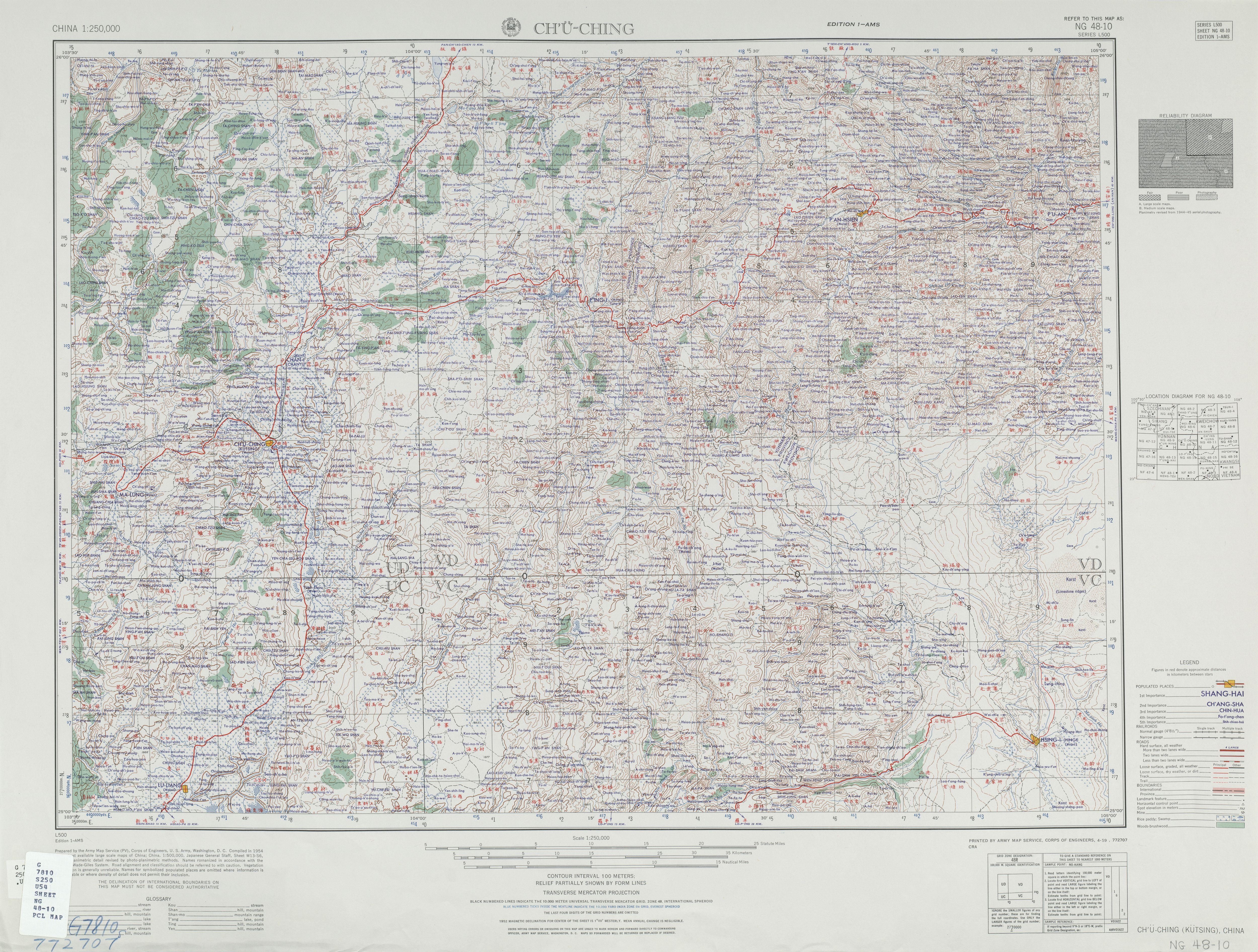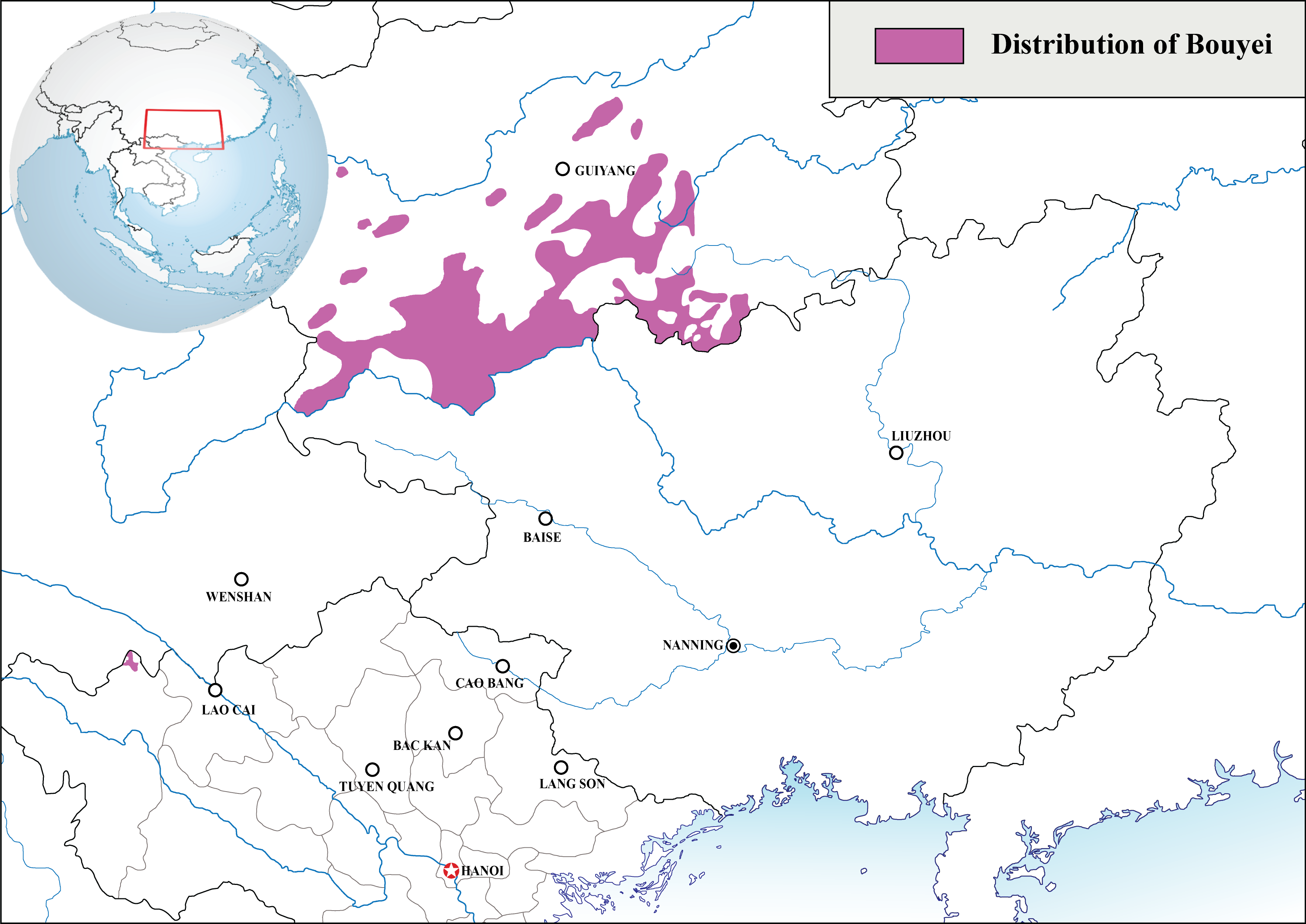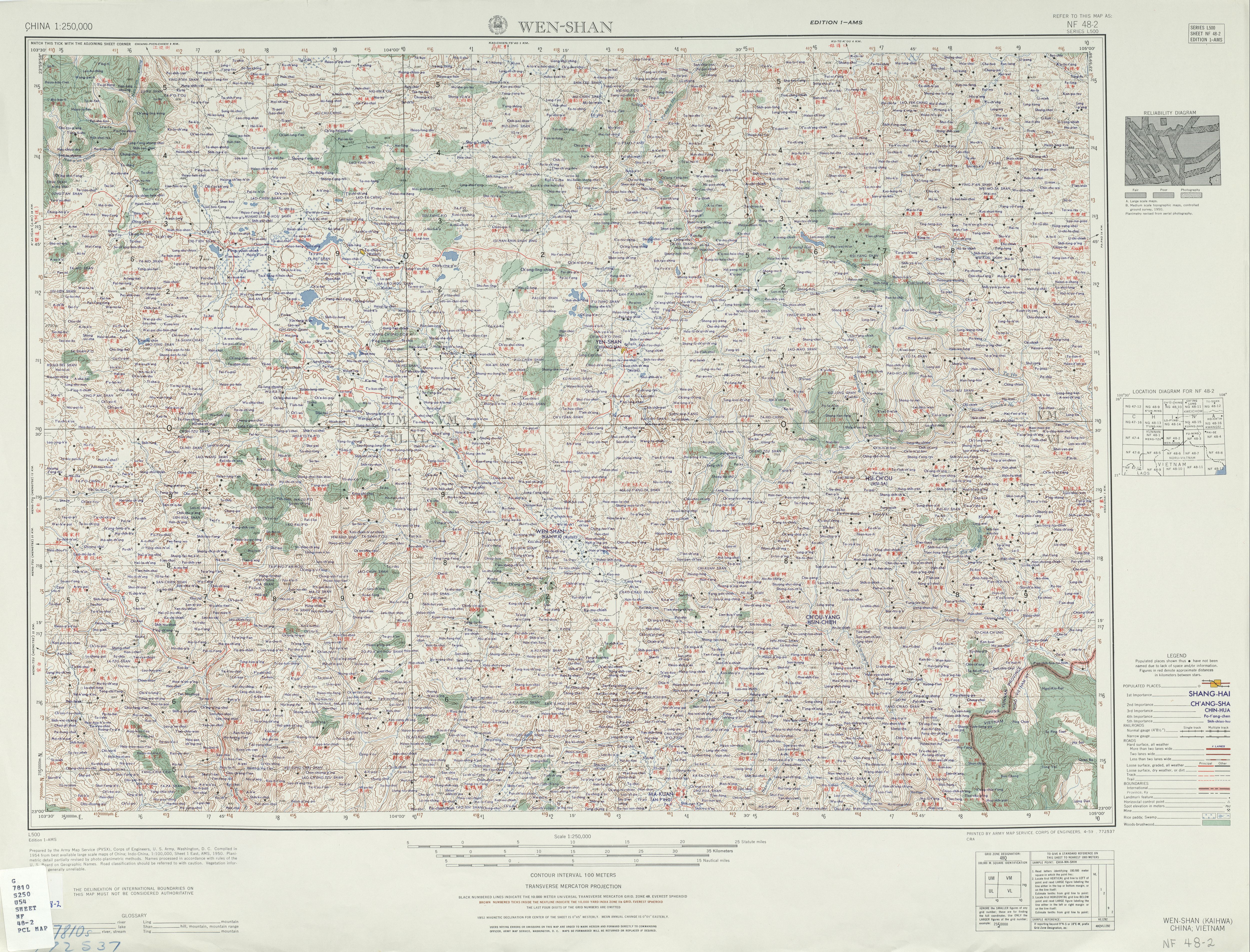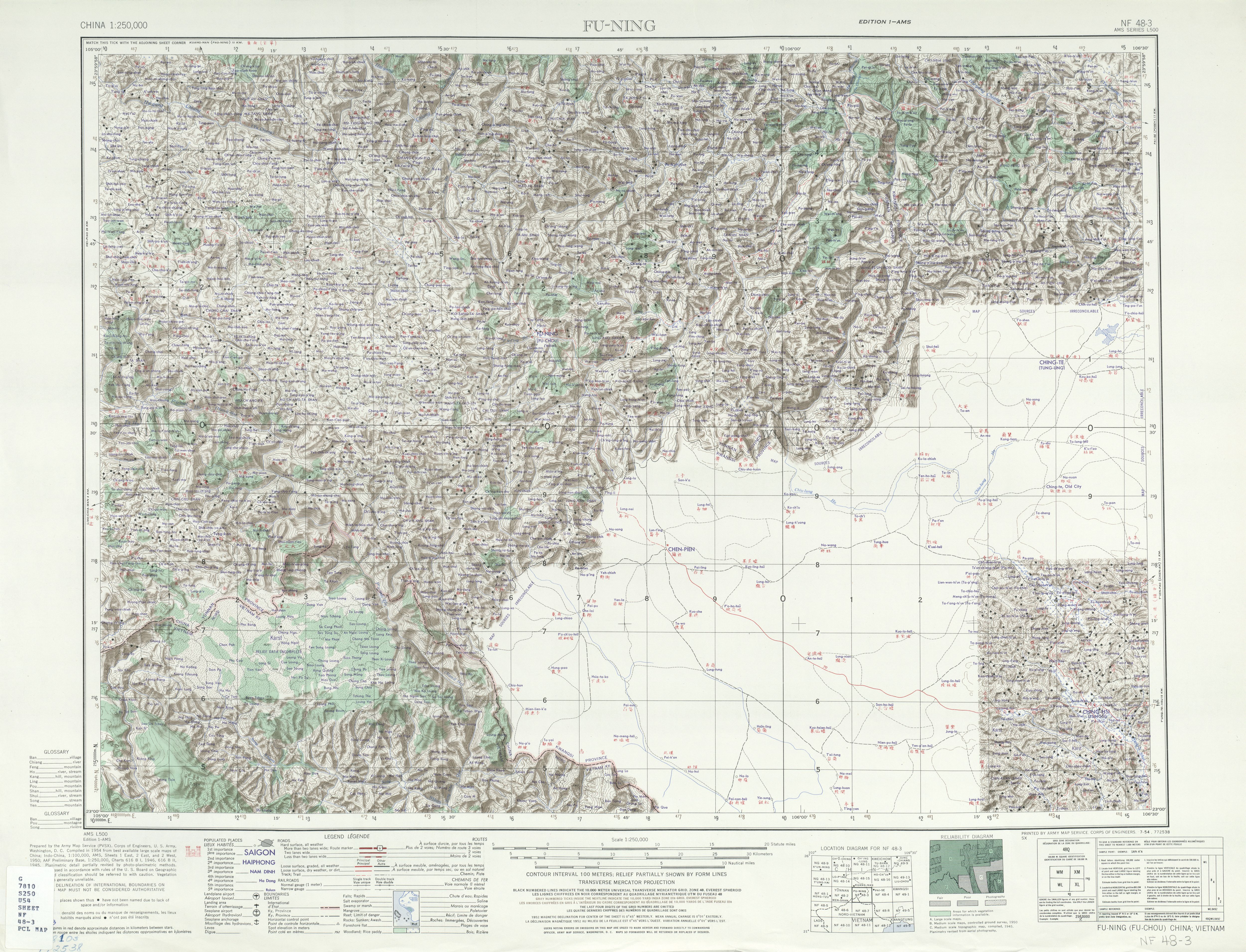|
Yei Zhuang Language
Yei Zhuang is a Northern Tai language complex spoken in Wenshan Prefecture, Yunnan, China. Its speakers are also known as the Sha (沙族). Distribution In Yunnan, Yei Zhuang dialects are spoken in Funing and Guangnan counties (also in Guangxi to the east and north), as well as Qiubei (probably also in Qujing Municipality to the north). The largest concentrations of Yei Zhuang speakers are found in Qiubei (80% of total Zhuang population) and Funing (50% of total Zhuang population) counties (Johnson 2011a:43). Po-ai, a Tai language of Funing County described by Fang-kuei Li in the mid-1900s, was determined by Johnson (2011b) to be a Yei Zhuang dialect. Names Below are various names (both autonyms and exonyms) for speakers of Yei Zhuang (Johnson 2011a:43). *pu Nong (濮侬) * (Qiubei) *bu Yai (布雅衣) *bu Yei (布依, 布瑞, 布越) *Shazu (沙族) or Sharen (沙人) *Baisha (白沙) *Nongqianbeng (侬迁绷) *Zhongjia (仲家) Many of these are names of Bouyei as well. ... [...More Info...] [...Related Items...] OR: [Wikipedia] [Google] [Baidu] |
China
China, officially the People's Republic of China (PRC), is a country in East Asia. It is the world's most populous country, with a population exceeding 1.4 billion, slightly ahead of India. China spans the equivalent of five time zones and borders fourteen countries by land, the most of any country in the world, tied with Russia. Covering an area of approximately , it is the world's third largest country by total land area. The country consists of 22 provinces, five autonomous regions, four municipalities, and two Special Administrative Regions (Hong Kong and Macau). The national capital is Beijing, and the most populous city and financial center is Shanghai. Modern Chinese trace their origins to a cradle of civilization in the fertile basin of the Yellow River in the North China Plain. The semi-legendary Xia dynasty in the 21st century BCE and the well-attested Shang and Zhou dynasties developed a bureaucratic political system to serve hereditary monarchies, or dyna ... [...More Info...] [...Related Items...] OR: [Wikipedia] [Google] [Baidu] |
Qujing
Qujing () is a prefecture-level city in the east of Yunnan province, China, bordering Guizhou province to the east and the Guangxi Zhuang Autonomous Region to the southeast; thus, it was called "Key between Yunnan and Guizhou" () and "Throat of Yunnan" () in the past. It is part of the Central Yunnan Metropolitan Region plan () in effect for 2016–49. Its administrative population is 6,047,000 according to a 2015 estimate, of whom, 1,408,500 reside in the metro area, which contains Qilin District, Zhanyi District and Malong District. During the 11th National Five-Year Plan period, the government of Qujing planned to develop the city into the "big city at the origin of the Pearl River" () in the following decades, including increasing the built-up urban area to past and the urban population to surpass 1 million by 2020, the second in Yunnan, after Kunming. Geography and climate Qujing is located in the east of Yunnan province, about east of Kunming, the provincial capital. ... [...More Info...] [...Related Items...] OR: [Wikipedia] [Google] [Baidu] |
Proto-Tai Language
Proto-Tai is the reconstructed proto-language (common ancestor) of all the Tai languages, including modern Lao, Shan, Tai Lü, Tai Dam, Ahom, Northern Thai, Standard Thai, Bouyei, and Zhuang. The Proto-Tai language is not directly attested by any surviving texts, but has been reconstructed using the comparative method. It was reconstructed in 1977 by Li Fang-KueiLi, Fang-Kuei. (1977). ''A handbook of comparative Tai''. Manoa: University Press of Hawaii. and by Pittayawat Pittayaporn in 2009.Pittayaporn, Pittayawat. (2009a)''The Phonology of Proto-Tai (Doctoral dissertation)''.Department of Linguistics, Cornell University. Phonology Consonants The following table shows the consonants of Proto-Tai according to Li Fang-Kuei's ''A Handbook of Comparative Tai'' (1977), considered the standard reference in the field. Li does not indicate the exact quality of the consonants denoted here as and which are indicated in his work as �, čh, žand described merely as palatal af ... [...More Info...] [...Related Items...] OR: [Wikipedia] [Google] [Baidu] |
Standard Zhuang
Standard Zhuang (autonym: , , (pre-1982: ; Sawndip: ); ) is the official standardized form of the Zhuang languages, which are a branch of the Northern Tai languages. Its pronunciation is based on that of the Yongbei Zhuang dialect of Shuangqiao Town in Wuming District, Guangxi with some influence from Fuliang, also in Wuming District, while its vocabulary is based mainly on northern dialects. The official standard covers both spoken and written Zhuang. It is the national standard of the Zhuang languages, though in Yunnan a local standard is used. Phonology The following displays the phonological features of the Wuming and northern dialects of Zhuang: Consonants Among other northern dialects of Zhuang, may be heard as a or sound. Absent consonant produces . An unusual and rare feature that Zhuang possesses is the lack of /s/, which is a common fricative among most languages that have them (one other notable exception is in the Australian languages), and yet Zhuang ha ... [...More Info...] [...Related Items...] OR: [Wikipedia] [Google] [Baidu] |
Palatalized Consonants
In phonetics, palatalization (, also ) or palatization is a way of pronouncing a consonant in which part of the tongue is moved close to the hard palate. Consonants pronounced this way are said to be palatalized and are transcribed in the International Phonetic Alphabet by affixing the letter ⟨ʲ⟩ to the base consonant. Palatalization cannot minimally distinguish words in most dialects of English, but it may do so in languages such as Russian, Mandarin, and Irish. Types In technical terms, palatalization refers to the secondary articulation of consonants by which the body of the tongue is raised toward the hard palate and the alveolar ridge during the articulation of the consonant. Such consonants are phonetically palatalized. "Pure" palatalization is a modification to the articulation of a consonant, where the middle of the tongue is raised, and nothing else. It may produce a laminal articulation of otherwise apical consonants such as and . Phonetically palatalized consonan ... [...More Info...] [...Related Items...] OR: [Wikipedia] [Google] [Baidu] |
Bouyei Language
The Bouyei language (autonym: Haausqyaix, also spelled ''Buyi'', ''Buyei'' or ''Puyi''; ; vi, tiếng Bố Y or ) is a language spoken by the Bouyei ethnic group of Southern Guizhou Province, China. Classified as a member of the Northern Tai group in the Tai language branch of the Tai–Kadai language family, the language has over 2.5 million native speakers and is also used by the Giay people ( vi, Giáy) in some parts of Vietnam. There are native speakers living in France or the United States as well, which emigrated from China or Vietnam. About 98% of the native speakers are in China. Bouyei's characteristics are similar to the other members of its language branch. It is generally monosyllabic and word order and particles are the main forms of grammar. Bouyei's syllable initials match up closely to the other Northern Tai languages, with relatively fast simplification and merging. Bouyei sentences can be shown to contain many different levels of phrasing. The contemporary ... [...More Info...] [...Related Items...] OR: [Wikipedia] [Google] [Baidu] |
Endonym And Exonym
An endonym (from Greek: , 'inner' + , 'name'; also known as autonym) is a common, ''native'' name for a geographical place, group of people, individual person, language or dialect, meaning that it is used inside that particular place, group, or linguistic community in question; it is their self-designated name for themselves, their homeland, or their language. An exonym (from Greek: , 'outer' + , 'name'; also known as xenonym) is an established, ''non-native'' name for a geographical place, group of people, individual person, language or dialect, meaning that it is used only outside that particular place, group, or linguistic community. Exonyms exist not only for historico-geographical reasons but also in consideration of difficulties when pronouncing foreign words. For instance, is the endonym for the country that is also known by the exonym ''Germany'' in English, in Spanish and in French. Naming and etymology The terms ''autonym'', ''endonym'', ''exonym'' and ''xe ... [...More Info...] [...Related Items...] OR: [Wikipedia] [Google] [Baidu] |
Fang-kuei Li
Li Fang-Kuei (Chinese: 李方桂, Cantonese: Lei5 Fong1 Gwai3 ej˩˨ fɔŋ˦ gʷaj˧, Mandarin: Lǐ Fāngguì i˨ faŋ˦ gʷej˥˩ 20 August 190221 August 1987) was a Chinese linguist known for his studies of the varieties of Chinese, his reconstructions of Old Chinese and Proto-Tai, and his documentation of Dene languages in North America. Biography Li Fang-Kuei was born on 20 August 1902 in Canton (Guangzhou) during the final years of the Qing dynasty to a minor scholarly family from Xiyang, a small town in Shanxi roughly south of Yangquan. Li's father Li Guangyu () received his ''jinshi'' degree in 1880 and served in minor official posts in the late 19th to early 20th century. Li was one of the first Chinese people to study linguistics outside China. Originally a student of medicine, he switched to linguistics when he went to the United States in 1924. He gained a BA in linguistics at the University of Michigan in 1926 after only two years of study. He then did graduate ... [...More Info...] [...Related Items...] OR: [Wikipedia] [Google] [Baidu] |
Qiubei County
Qiubei County () is under the administration of the Wenshan Zhuang and Miao Autonomous Prefecture, in southeast Yunnan province, China. Administrative divisions In the present, Qiubei County has 3 towns, 4 townships and 5 ethnic townships. ;3 towns * Jinping () * Yuezhe () * Shuanglongying () ;4 townships ;5 ethnic townships Ethnic groups The ''Qiubei County Gazetteer'' 丘北县志 (1999) lists the following ethnic subgroups. *Han * Zhuang *Miao **Green Miao 青苗 (autonym: Mengshi 蒙史) **White Miao 白苗 (autonym: Mengdou 蒙斗) **Flowery Miao 花苗 (autonym: Mengzhua 蒙爪) * Yao **Landian Yao 蓝靛瑶 **Daban Yao 大板瑶 **Guoshan Yao 过山瑶 * Yi **Naisoupo 乃叟泼 (Black Yi 黑彝) **Guopo 锅泼 or Boren 僰人 (White Yi 白彝) **Sanipo 撒尼泼 (Sani 撒尼): in Badaoshao 八道哨, Shuanglongying 双龙营, and Yuezhe 曰者 (''Wenshan Prefecture Ethnic Gazetteer'' 2005:352) **Poulongpo 剖笼泼 (Pula 仆拉) **Boren 僰人: in Shede 舍得 (in Ba ... [...More Info...] [...Related Items...] OR: [Wikipedia] [Google] [Baidu] |
Wenshan Zhuang And Miao Autonomous Prefecture
Wenshan Zhuang and Miao Autonomous Prefecture is an autonomous prefecture in southeastern Yunnan Province, People's Republic of China and the easternmost prefecture-level division of the province. It borders Baise, Guangxi to the east, Vietnam's Hà Giang Province to the south for , Honghe Hani and Yi Autonomous Prefecture to the west and Qujing to the north. Subdivisions Ethnic groups Wenshan is highly diverse. According to a local saying, "Han and Hui live by the market, Zhuang and Dai live by the water, Miao and Yi live on the mountains, and Yao live among the bamboos." () Some of Wenshan's ethnic groups include: *Han Chinese *Tai peoples ** Zhuang (3 branches according to Kaup (2000); 4 branches according to Johnson (2011)Johnson, Eric C. 2011.A Lexical and Phonological Comparison of the Central Taic Languages of Wenshan Prefecture, China: Getting More Out of Language Survey Wordlists Than Just Lexical Similarity Percentages. SIL Electronic Working Papers 2011-005: 170. ... [...More Info...] [...Related Items...] OR: [Wikipedia] [Google] [Baidu] |
Guangnan County
Guangnan County (; Zhuang: ) is located in Wenshan Zhuang and Miao Autonomous Prefecture, Yunnan province, China. The seat of Guangnan, known today as Liancheng (), was the heart of the Gouding Kingdom () that lasted approximately 400 years, from 111 BC to 316 AD. Administrative divisions In the present, Guangnan County has 7 towns and 11 townships. ;7 towns ;11 townships Climate Guangnan, as with much of southern Yunnan, has a warm humid subtropical climate (Köppen ''Cwa''), with muddled distinction between the seasons and daytime temperatures remaining warm year-round. The warmest and coolest months are July and January, respectively at and ; the annual mean is . May thru September accounts for nearly 75% of the annual rainfall of Ethnic groups The following information in this section is from the ''Guangnan County Gazetteer'' () (2001). *Han *Zhuang *Miao **White Miao 白苗 (or Menglou 蒙娄) **Sinicized Miao 汉苗 Lopsided Miao 偏苗 (or Mengsha 蒙纱) * ... [...More Info...] [...Related Items...] OR: [Wikipedia] [Google] [Baidu] |
Funing County, Yunnan
Funing County (; Zhuang language: ) is located in Wenshan Zhuang and Miao Autonomous Prefecture, in the east of Yunnan province, China. It is the easternmost county-level division of Yunnan, bordering Guangxi to the north, east and southeast, and Vietnam's Hà Giang Province to the south. Administrative divisions In the present, Funing County has 6 towns, 6 townships and 1 ethnic township. ;6 towns ;6 townships ;1 ethnic township * Dongbo Yao () Ethnic groups Ethnic groups of Funing County include the following. Population statistics are from 1990, and are sourced from the ''Funing County Ethnic Gazetteer'' (1998). *Han Chinese (84,337 people) *Zhuang people (199,784 people, including the Buyang) ** Min ZhuangJohnson, Eric C. 2011.A Lexical and Phonological Comparison of the Central Taic Languages of Wenshan Prefecture, China: Getting More Out of Language Survey Wordlists Than Just Lexical Similarity Percentages. SIL Electronic Working Papers 2011-005: 170. ** Dai Zhuang (" ... [...More Info...] [...Related Items...] OR: [Wikipedia] [Google] [Baidu] |





